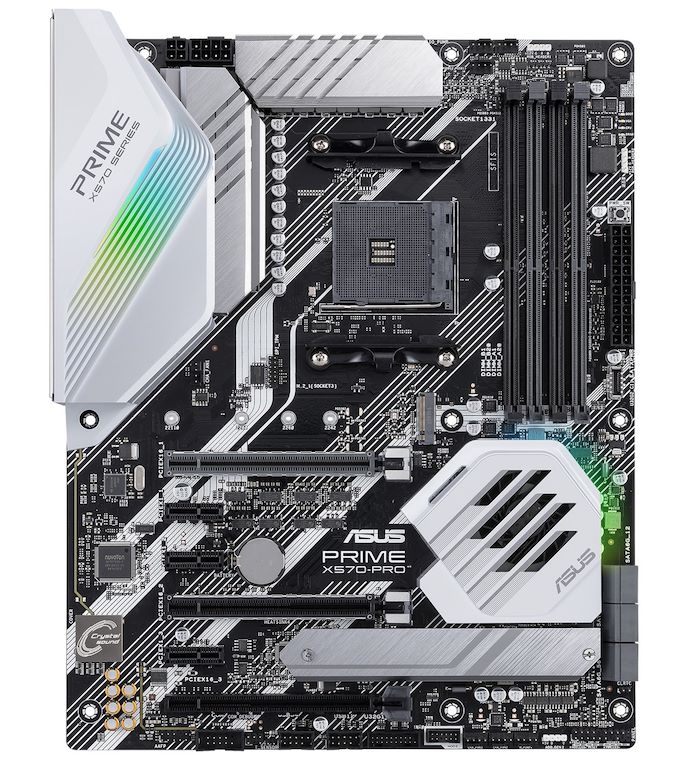The AMD X570 Motherboard Overview: Over 35+ Motherboards Analyzed
by Gavin Bonshor on July 9, 2019 8:00 AM ESTASUS Prime X570-Pro
Moving onto the ASUS Prime series of X570 motherboards, the ASUS Prime X570-Pro represents the more feature-laden of two ATX sized models; the other being the ASUS Prime X570-P. The ASUS Prime X570-Pro represents its less aggressive and non-gaming Prime range with a more subtle white and black aesthetic. The most notable aspects of the feature set include a Realtek S1220A HD audio codec, Gigabit NIC, and support for up to 128 GB of DDR4 memory.
The ASUS Prime X570-Pro offers three full-length PCIe 4.0 slots which run at x16, x8/x8, and x8/x8/x4. This allows for users to use two-way NVIDIA SLI and up to three-way AMD Crossfire multi-graphics card setups. Also present is three PCIe 4.0 x1 slots, with the board's storage capabilities coming through two PCIe 4.0 x4 M.2 slots, with the bottom slot coming with a heatsink; there are also six SATA ports with support for RAID 0, 1 and 10 arrays. In the top right-hand corner is four memory slots with support for up to 128 GB which allows users to install the 32 GB UDIMMs that has started making its way onto the market.
On the rear panel, the ASUS Prime X570-Pro includes three USB 3.1 G2 Type-A, one USB 3.1 G2 Type-C, and four USB 3.1 G1 Type-A ports. Adopters of AMD's impending Ryzen 3000 APUs and the Ryzen 2400/2200G will appreciate the HDMI and DisplayPort video outputs. There is also a PS/2 keyboard and mouse combo port, an Intel I211-AT Gigabit powered Ethernet port, and five 3.5 mm audio jacks and S/PDIF optical output driven by a Realtek S1220A HD audio codec.
The ASUS Prime X570-Pro has an MSRP of $250 and is more suited to users looking to avoid the swathe of gaming-themed models on the market. What the Prime series offers is elegant and neutral designs, which would actually look quite good with some RGB to make the white rear panel cover pop. There's support for two-way NVIDIA SLI and three-way AMD CrossFire too so users looking to build a more subtly styled gaming system can do so.












225 Comments
View All Comments
Death666Angel - Wednesday, July 10, 2019 - link
And with doublers that means the load gets distributed among more DrMOS and increases the power delivery capabilities of the board. Depending on the doublers it can be very intelligent or just a brute force approach. Still better to have a (4x2) Vcore than a (4) Vcore, everything else being the same.gavbon - Wednesday, July 10, 2019 - link
It's all tongue in cheek for me. I've been pulling all-nighters for the last 2 weeks getting everything together. I've updated now, but MSI did say in an email 4+1 because I asked them to clarify. You are right though!Showtime - Tuesday, July 9, 2019 - link
ITX pricing? I was planning to go AMD this round, but Idk about $220+ mobo for a $200 CPU. Might have to go back to intel depending on sales.RSAUser - Wednesday, July 10, 2019 - link
Then get a B450 board.mikato - Thursday, July 11, 2019 - link
Will it work if I build a new comp with a Ryzen 3000? I do not have any spare CPUs. I think I’ll have to ask some mobo companies. Some may allow you to update BIOS without requiring a (older) compatible CPU by using a flash drive.Alex Topfer - Tuesday, July 9, 2019 - link
Can you add a table of which ones don't/do have RGB lighting?boozed - Wednesday, July 10, 2019 - link
HahahaPeachNCream - Wednesday, July 10, 2019 - link
Bwahahahaha!The_Assimilator - Wednesday, July 10, 2019 - link
Asus "WS" boards are the sole ones lacking it nowadays. :( I hate paying the "RGB tax" too but thankfully all boards allow it to be hard-disabled in the BIOS (this generation at least...).mikato - Thursday, July 11, 2019 - link
Did you see ASRock?